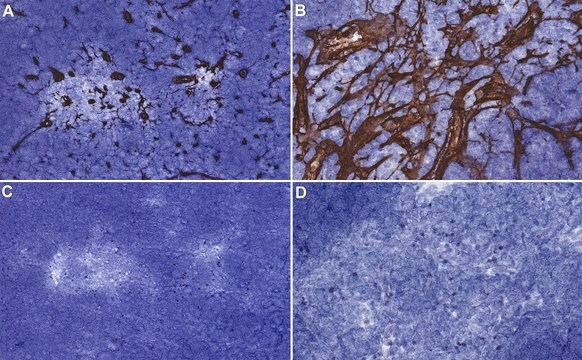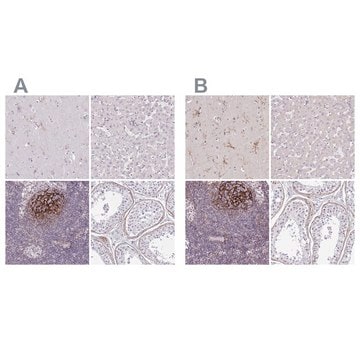General description
We are committed to bringing you greener alternative products, which adhere to one or more of The 12 Principles of Green Chemistry. This antibody is Preservative-free, produced without the harm or sacrifice of animals and exceptionally stable to allow for ambient shipping and storage if needed and thus aligns with "Waste Prevention", "Designing Safer Chemicals" and "Design for Energy Efficiency".
Click here for more information.
ZooMAb® antibodies represent an entirely new generation of recombinant monoclonal antibodies. Each ZooMAb® antibody is manufactured using our proprietary recombinant expression system, purified to homogeneity, and precisely dispensed to produce robust and highly reproducible lot-to-lot consistency. Only top-performing clones are released for use by researchers. Each antibody is validated for high specificity and affinity across multiple applications, including its most commonly used application. ZooMAb® antibodies are reliably available and ready to ship when you need them.
Specificity
Clone 2C12 is a ZooMAb® rabbit recombinant monoclonal antibody that specifically detects P2Y purinoceptor 12 (P2RY12). It targets an epitope within 22 amino acids from the C-terminal, cytoplasmic domain.
Immunogen
KLH-conjugated linear peptide corresponding to 22 amino acids from the C-terminal, cytoplasmic domain of human P2Y purinoceptor 12 (P2Y12).
Application
Quality Control Testing
Evaluated by Western Blotting in Bovine cerebellum tissue lysate.
Western Blotting Analysis: A 1:1,000 dilution of this antibody detected P2RY12 in Bovine cerebellum tissue lysate.
Tested Applications
Western Blotting Analysis: A 1:1,000 dilution from a representative lot detected P2RY12 in Human cerebellum tissue lysate.
Immunohistochemistry (Paraffin) Analysis: A 1:1,000 dilution from a representative lot detected P2RY12 in human cerebral cortex tissue sections.
Immunofluorescence Analysis: A 1:1,000 dilution from a representative lot detected P2RY12 in human cerebral cortex tissue sections.
Note: Actual optimal working dilutions must be determined by end user as specimens, and experimental conditions may vary with the end user.
Target description
P2Y purinoceptor 12 (UniProt: Q9H244; also known as P2Y12, ADP-glucose receptor, ADPG-R, P2T(AC), P2Y(AC), P2Y(cyc), P2Y12 platelet ADP receptor, P2Y(ADP), SP1999) is encoded by the P2RY12 (also known as HORK3) gene (Gene ID: 64805) in human. P2Y receptors are a family of purinergic G-protein-coupled receptors (GPCRs) that are activated by extracellular nucleotides. Eight distinct functional P2YRs expressed are expressed in in human, which are subdivided into P2Y1-like receptors and P2Y12-like receptors. P2Y12 receptor is a multi-pass membrane protein with four extracellular domains, seven transmembrane domains, and four cytoplasmic domains. Most of its transmembrane domains appear to be tilted and/or kinked. Binding of agonists to P2Y12 receptor promotes a conformation change in the extracellular loops that leads to an inward movement of the transmembrane helices. It serves as a receptor for ADP and ATP coupled to G-proteins that inhibit the adenylyl cyclase second messenger system. It is not activated by UDP and UTP. It is highly expressed in the platelets and lower level of expression is observed in the brain, lung, and adrenal glands. It is required for normal platelet aggregation and blood coagulation. It is the predominant receptor involved in the ADP-stimulated activation of the glycoprotein IIb/IIIa receptor. Activation of the glycoprotein IIb/IIIa receptor results in enhanced platelet degranulation and thromboxane production, and prolonged platelet aggregation. P2Y12 receptor has also been reported to be expressed on microglia and is required to neuropathic pain following peripheral nerve injury. Mutations in P2RY12 gene have been linked to bleeding disorders resulting from severe impairment of platelet response to ADP resulting in defective platelet aggregation. This ZooMAb® recombinant monoclonal antibody, generated by our propriety technology, offers significantly enhanced specificity, affinity, reproducibility, and stability over conventional monoclonals. (Ref.: Zhang, K., et al. (2014). Nature. 509(7498); 115-118; Burnstock G. (2009). Curr. Pharm. Des. 15(15);1717-35; Damman, P., et al. (2012). J. Thromb. Thrombolysis. 33(2); 143-153).
Physical form
Purified recombinant rabbit monoclonal antibody IgG, lyophilized in PBS, 5% Trehalose, normal appearance a coarse or translucent resin. The PBS/trehalose components in the ZooMAb formulation can have the appearance of a semi-solid (bead like gel) after lyophilization. This is a normal phenomenon. Please follow the recommended reconstitution procedure in the data sheet to dissolve the semi-solid, bead-like, gel-appearing material. The resulting antibody solution is completely stable and functional as proven by full functional testing. Contains no biocide or preservatives, such as azide, or any animal by-products. Larger pack sizes provided as multiples of 25 µL.
Reconstitution
0.3 mg/mL after reconstitution at 25 µL per vial. Please refer to guidance on suggested starting dilutions and/or titers per application and sample type.
Storage and Stability
Recommend storage of lyophilized product at 2-8°C; Before reconstitution, micro-centrifuge vials briefly to spin down material to bottom of the vial; Reconstitute each vial by adding 25 µL of filtered lab grade water or PBS; Reconstituted antibodies can be stored at 2-8°C, or -20°C for long term storage. Avoid repeated freeze-thaws.
Other Notes
Concentration: Please refer to the Certificate of Analysis for the lot-specific concentration.
Legal Information
ZooMAb is a registered trademark of Merck KGaA, Darmstadt, Germany
Disclaimer
Unless otherwise stated in our catalog or other company documentation accompanying the product(s), our products are intended for research use only and are not to be used for any other purpose, which includes but is not limited to, unauthorized commercial uses, in vitro diagnostic uses, ex vivo or in vivo therapeutic uses or any type of consumption or application to humans or animals.










